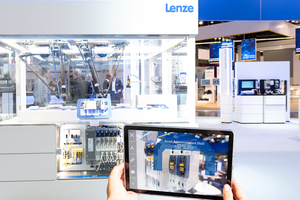

|
Edward Lowton
Editor |


|
| Home> | Plant, Process & Control | >Automation | >Smart servo axis with IIoT functions |
Smart servo axis with IIoT functions
25 September 2020
LENZE'S SMART servo axis combines a i950 inverter, g700 planetary gearbox and m850 synchronous motor to cover high-precision positioning tasks as well as dynamic handling and assembly applications, robotics, and conveyor solutions. It also acts as a comprehensive data source for IIoT and service models; the smart inverter makes the use of additional sensors unnecessary.

The adaptation of different tasks and concepts in industrial automation requires high computing power on the one hand, and on the other hand intelligent functions with which the requirements of Industry 4.0 can be efficiently implemented. The Lenze i950 inverter is designed precisely for these requirements.
One example is its unusually dynamic control performance. The inverter's optimized kinematics take into account both the drive axis itself and the control path behind it. This means that faults and deviations are corrected much faster than with standard inverters on the market. As a result, the target value is restored in less time, and the deviation from normal operation of the servo axis is only minimal.
During operation, this pays off twice over. On the one hand, there is the high precision in positioning, as required for example in print shops. High-quality print products can only be produced with exact ink application. On the other hand, in the higher speed that can be driven. Viewed over the entire press, this advantage adds up to a 20 percent higher cycle rate. For the user, this means a considerable gain in performance and efficiency, which is not bought at the expense of lower quality but is accompanied by better results.
Information centre for IIoT
Future-proof factory automation must take into account the development towards the Industrial Internet of Things (IIoT) - the intelligent use of data to make machines smarter and more flexible, to make servicing and maintenance more efficient and to enable new OEM sales and service models.
But where does the required data come from? The seemingly simplest answer is additional sensors. But they involve a lot of effort: wiring and control systems become more complex, planning and installation costs rise, as do the costs for materials and maintenance. But Lenze shows that there is another way. Intelligent use of the data already available from the servo axis makes additional components superfluous. Instead, the drive itself becomes a sensor that lays the foundation for services such as condition monitoring. The Lenze development experts advise their partners on how to detect belt tension, friction and inertia anomalies in existing data and how to generate profitable new service models from this data.
Easy access to the cloud
Data processing for condition monitoring and predictive maintenance can be handled by the powerful i950 at the edge. However, IIoT also means networking beyond the individual machine, for example to monitor different systems together, to maintain different locations centrally or to benchmark. Such more complex tasks are usually handled via cloud services that enable the use of machine learning (ML) and artificial intelligence (AI). A simple way to transfer data from the powertrain to IIoT is therefore essential.
With the x500 gateway, combined with the X4 Remote platform, machine builders receive a ready to use cloud solution from Lenze that includes continuous condition monitoring, remote machine maintenance and user-friendly asset management. OEMs and users are free to choose the cloud provider to build their IIoT platform.
Easily networked
Lenze also meets the requirements of mechanical engineering when it comes to wiring. The standardized One-Cable-Technology (OCT) further simplifies the design of the machine. Instead of separate supply and data lines, only one single connection is required. The open motor feedback protocol transmits the motor data digitally. In the case of Lenze's MCS and m850 series drives, for example, it also transmits the encoder signal and motor temperature. This is also part of the "drive as sensor" concept, as resolvers and motor temperature sensors can be omitted here. Less wiring reduces material costs and saves space in the control cabinet. In addition, potential sources of error are reduced: connection and wiring related failures become less frequent, and finding the cause is easier because fewer options have to be tested.
- Intelligent drive tailored for conveyors
- Lenze updates Drive Solutions Designer
- High power density
- Drive designer
- Celebrating 70 years
- Virtual Reality demonstrations
- Drive protection for heavy duty machines
- Big ideas in motion and control on show at IntraLogisteX
- Automation platform for the processing and packaging industry
- Speed check for beer as it flows into barrels
- Latest software
- Compact robot controller
- Standard machine elements from Elesa
- test baner
- Baking automation
- Higher payload
- Power supplies controlled via web
- New Eiger freezer door installed as business heats up at leading meat packaging company
- Linear and rotary combination
- High temperature chain fluid


















